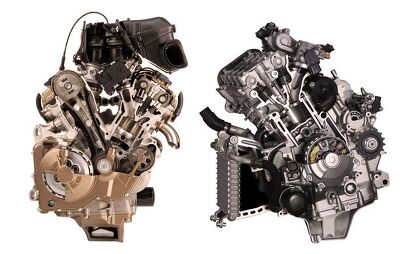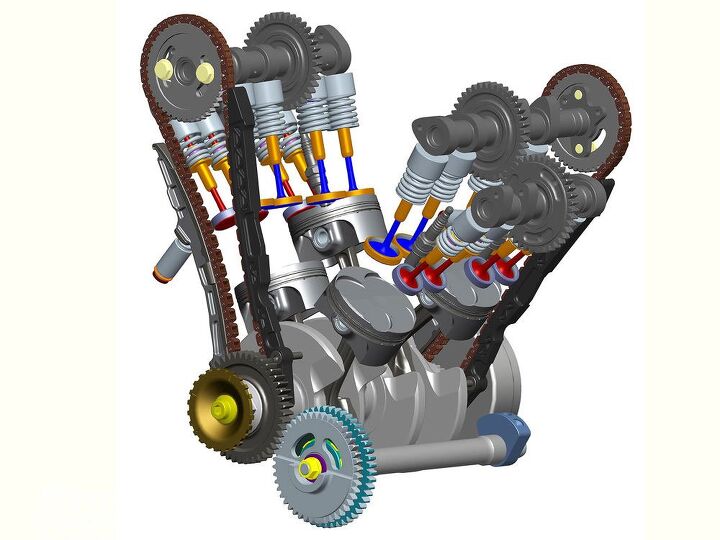Ask MO Anything: V-Four or Inline?
Dear MOby,
The article about why Suzuki did not use a Crossplane crankshaft firing order on their new GSXR was really enlightening. I wanted to follow up with another question: Why not a V-Four? MotoGP appears to favor V-Four engines but only Aprilia has chosen the V-Four for their production liter bike. I always thought the V-Four was more complicated and the added components also added weight. Is this true?
Jordan
Mission Viejo, CA
You’re exactly correct in that a V-Four is a more complicated and therefore more expensive design requiring two cylinder heads instead of one, two sets of cam drive apparatus, and machining two surfaces of the crankcases to accept them. All of which explain why Aprilia is the only superbike manufacturer to offer one lately, bless their Italian hearts. Whether a Vee arrangement offers a performance advantage is mostly a matter of conjecture, but when it comes to engine texture and aural pleasure, just about everybody at MO agrees a nice V-Four is impossible to beat.
In the 500cc two-stroke era, it was easier to package four smaller, camless cylinders in all sorts of V- and or square-Four configurations. But in the contemporary MotoGP era with 990cc four-strokes, space is considerably tighter. In moving from YZR-500 V-Four two-stroke to YZR-M1 four-stroke in 2002 for MotoGP, Yamaha went from a 500cc V-Four to a 990cc Inline Four.
Inside Yamaha’s MotoGP Race Shop
Suzuki’s GSX-RR is also an Inline. Honda, Aprilia and Ducati choose V-Four configurations for their MotoGP operations, and KTM will be back next year with its all-new V-Four-powered RC 16. (Meanwhile in World Superbike, Honda relies on its Inline CBR to battle the dominant Inlines of Kawasaki and the Ducati V-Twin, which manages to hang in there thanks to its 20% displacement advantage.)
As horsepower has increased to 240 or more in MotoGP, keeping the front wheel on the ground has become increasingly difficult under acceleration, and moving weight forward with an inline-Four helps achieve that. At the same time there’s a fine line between weighting the front end and maintaining rear-wheel traction. Before fuel injection and electronic traction control, a nice, mass-centralized V-Four was a great way to keep most of the engine’s weight in the best place to fine-tune that balance – with the added potential of exotic firing orders that might increase traction. A V-Four was of course narrower, too, which was a big deal in the case of early Superbikes.
2015 Six-Pack Superbike Shootout Final Answer!
Do those principles still apply now that electronics are monitoring rear-wheel traction, keeping the bike from wheelying over backwards as well as keeping the rear tire from locking up under braking? Everybody has their theories, and that’s what makes bike racing fun to watch, really. At yesterday’s Japanese MotoGP, both Inline-Four Yamaha multi-time champion riders lost the front in very similar crashes, taking themselves out of the race and the championship battle. Meanwhile, Marc Marquez on the V-Four Honda, running similar lap times on the same tires, kept his bike upright and clinched the 2016 title. Is it the bike or the rider? It’s both, of course, which makes the conjecturing so rich. Marquez’s hyper-braking style, aided by the Honda’s less-forward weight bias, has bitten him almost as many times as it’s saved him.
Our man at MV Agusta*, Brian Gillen, has this to say: “Both Honda and Ducati have proven that a V-Four can win, as well as Yamaha demonstrating that an I-Four is also a winner [and Suzuki this year too].
At the moment, with the front winglets loading the front end under acceleration, and the need to maximize rear wheel grip for engine braking on corner entry, engine position has moved progressively towards the rear tire. It will be interesting to see next year, with aero packages banned, if the V-Four engine configuration remains as competitive as it was this year. I would bank on an I-Four world champion in 2017… you read it here first!”
*Congratulations on another win by Jules Cluzel on the MV F3 675 at the World Supersport round in France October 2!
Direct your motorcycle-related questions to AskMoAnything@motorcycle.com, though some say we’re better at non-motorcycle-related ones…
More by John Burns


































Comments
Join the conversation
Much rather wrench on inline fours. GSXR's in particular are easiest to work on.
Inline 4 is easier to work on for sure! and way better gas mileage, still don't know why V-twins and V-4's get horrible gas mileage even after all these years. I go way back when honda came out with there V-4's when they said this is the future? Inline 4's could not get even close to that mid range NOW the inline 4's are so good. I seen many times the V-twin and the V-4 with will run out of gas 90% of the time before an inline 4.